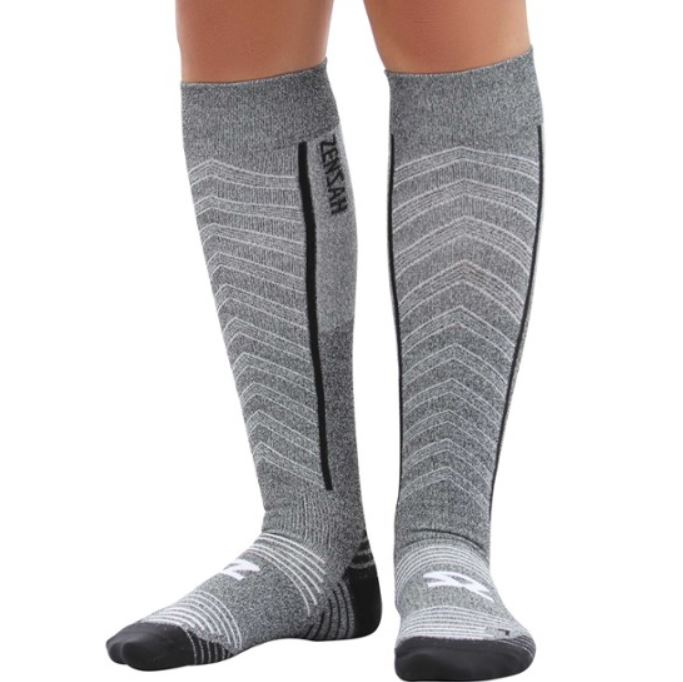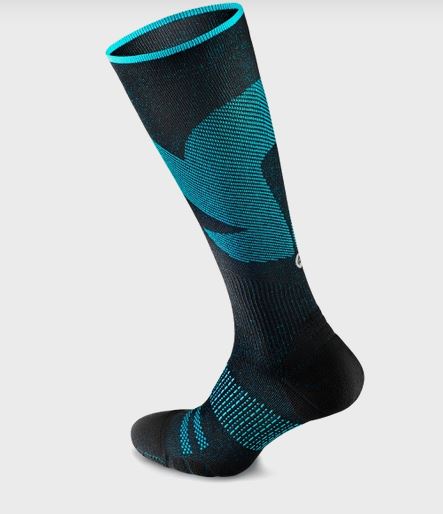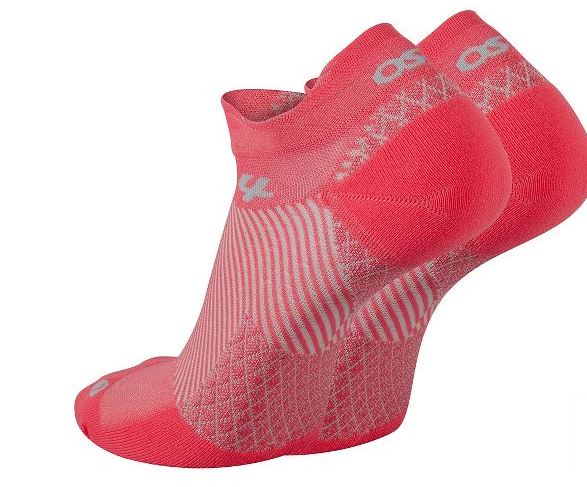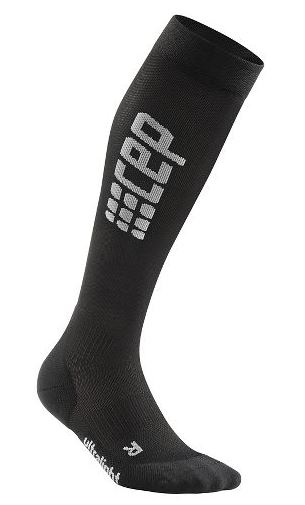Compression socks, usually made of 80% nylon and 20% spandex, conform snugly to the feet and calves reducing movement of the muscle during impact and increasing blood flow to the area.
Awesome…what does that mean?
The reduction of muscle movement is said to prevent energy waste and assist in maintaining proper body alignment. Meanwhile increased blood flow ensures that the muscles are receiving a constant supply of oxygen, which is required to sustain performance or enhance recovery.
Benefits of Compression Socks
- Reduce discomfort of shin splints and help with recovery
- Prevent tight calves while running and cramps
- Manage foot swelling during long runs
- Improve recovery times
- Support for plantar fasciitis or Achilles problems
- Tight fit can reduce blisters
- Useful for preventing deep vein thrombosis on long flights
I started using them during races to prevent calf cramps and it’s worked like a charm. But they’re also part of my ongoing marathon training recovery plan.
Which is exactly what a brand new study found:
A new study provides scientific evidence to support the idea that your compression socks are not just fashionable, they’re also functional….wearing compression socks for 48 hours after running a marathon improved performance on a treadmill test two weeks later.
Just as there are different types of compression pants, there are different types of compression socks.
Best Compression Socks for Running
Depending on your needs, there are some different things to consider. It’s incredibly important to try running with them a few times before race day.
Compression socks might not be the most stylish of gear, but they work and so now it’s really about what you need in socks for running.
There are plenty of options to find a good level of compression and in just about any color you desire.
Compression Sleeves
I personally do not love sleeves because I want the full benefit of the compression through my feet. And you SHOULD NOT wear sleeves on a plane due to the potential pooling of blood in the feet.
But, some runners have found they dislike the way compression feels on their feet and how much looser it can make shoes feel. And really…can I argue with Meb??

- CEP calf sleeves – they are a super high quality brand, which means these will last and you can get them in super fun colors.
- ProCompression – I have a pair of their socks and assume the sleeves must be every bit as good! Again they also really love coming up with fun patterns, so your race day look is always top notch.
Now back to finding a pair of compression socks!
Graduated Compression Socks
Designed to provide the most comfortable and beneficial fit for you a graduated compression sock will have the most compression starting in the foot or ankle and then decreasing through the top of the calf.
✅VitalSox are actually the first brand I ever wore and still recommend because their graduation starts at the foot to give your arch and ankle the most benefit of the sock.
Available in a variety of colors and at a great price, this is a winner.
Eco-Friendly Compression Socks
Rockay has an incredible compression sock that is also 100% recycled materials and come on tell me that doesn’t make you feel good?!
Love the way these wrap around the calf muscle and have a little different look than some others.
They’re also anti-odor and middle of the road in terms of thickness, which means good blister protection as well.
(Rockay pictured above comes in multiple color options)
Lightweight Compression Socks
When it comes to summer running you may find even more benefit to wearing compression socks as they will help with swelling. Since so many of our marathon miles take place in the heat, you might notice that your shoes start to feel tight during long runs or your feet don’t recover as quickly.
But of course we don’t want to add heat to our body, so here are a couple of options
- Zensah Featherweight – ultralight, plus the front ribbing is helpful for shin splints
- CEP – Ultralight tall socks are thinner, but without any sacrifice to running compression. Not a huge fan of the massive logo, but hey if they work, they work.
Low Cut Compression Socks
If you’re focused more on arch support or improving circulation in your feet, you may not need a tall sock.
In fact, I like wearing short ones after long runs because they just make my feet feel great. Ditto for a day where we might be walking around a ton.
- O1st – fantastic for Plantar Fascittis
- Balega – LOVE their socks for such a soft feel and good cushion
- CEP – Yup, they make an appearance again because they make a good product
Merino Wool Recovery Compression Socks
Great for recovery after those winter long runs are these Smartwool Merino Wool Socks.
First they’re cute, so for once not everyone will know you’re trying to be sneaky about recovery. Second thanks to the wool you’ll be warm, but also quickly wicking away any odor and they just feel nice.
I don’t think these have enough support to be used during the run.
What are the levels of compression socks for running?
You may notice that some socks list their millimeters of mercury as a range like “16-20mmHG”. This is a way of describing the level of compression as related to blood pressure.
In graduated socks the range will be the tighter compression to the foot and less at the top.
Here’s how to decide which range you’d like:
- 8-15mmHG is the lightest compression you’ll find and ideal for recovery
- 15-20mmHG a good option for shorter runs and recovery
- 20-30mmHG generally what you’ll find for running
- 30mmHG + is usually starting to get in to more medical grade use for swelling
Remember that if you’re having ankle pain while running, then compression socks aren’t going to resolve the issue. Figure out the root cause and then consider a good ankle running support.
Other ways to connect with Amanda
Instagram Daily Fun: RunToTheFinish
Facebook Community Chatter: RunToTheFinish
Get more running tips: Pinterest







 9 Types of Runners: Which One are You?
9 Types of Runners: Which One are You?